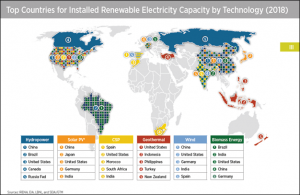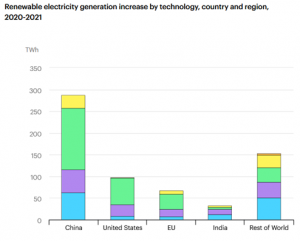INTERNATIONAL ENERGY REPORTS
Though this portal is focused mainly on domestic alternative energy activities, there are many projects underway globally, as well as legislation that has been issued to reduce carbon footprints and decrease dependence on fossil fuels. This portal by no means lists all of the projects or legislation being considered, but will provide a reasonable snapshot of energy-related decisions being made, by continent, around the globe. The top countries with installed renewable electricity capacity by technology as of 2018 is depicted in the following image.

Source: Department of Energy, 2020 [1]
According to the International Energy Agency (IEA), in 2020 as demand for all other fuels declined, renewable energy use increased 3%. An almost 7% growth in electricity generation from renewable sources was the primary driver. Other supporting factors include long-term contracts, priority access to the grid, and continuous installation of new plants, despite lower electricity demand, supply chain challenges, and construction delays in many parts of the world. Accordingly, the share of renewables in global electricity generation jumped up from 27% in 2019 to 29% in 2020. [2]
In 2021, renewable electricity generation was expected to expand by more than 8% to reach 8 300 TWh, the fastest year-on-year growth since the 1970s. Two-thirds of renewables growth was expected to come from solar PV and wind. Almost half of the global increase in renewable electricity in 2021 was expected to be attributable to China alone, followed by the United States, the European Union, and India. [3]

Source: International Energy Agency, 2020 [4]
As of 2023, global renewable capacity additions were predicted to grow by 107 gigawatts to more than 440 gigawatts by the end of 2023. Two-thirds of the projected increase are from solar PV capacity and onshore wind capacity is set to rebound 70% in 2023 due to the commissioning of delayed projects from the COVID-19 restrictions. Solar PV will continue to grow in 2024, however onshore wind additions are expected to fall by around 5% if policies are not implemented to drive this industry. The overall world renewable capacity is forecast to reach 4,500 GW by the end of 2024.[5]
Updated by Erin George, December 2023

Comments are closed.